Health System and Change: Patient Experience Questionnaire Report
VerifiedAdded on 2023/01/23
|9
|2826
|96
Report
AI Summary
This report analyzes a healthcare system's initiative to implement the 'Australian Hospital Patient Experience Question Set' (AHPEQS) to evaluate and improve services from the patient's perspective. As a departmental manager, the author details the process, including administering the survey, conducting monthly multidisciplinary meetings to discuss results, identifying areas for improvement, and developing action plans. The report highlights the importance of addressing workplace disruptions, fostering interdisciplinary collaboration, and ensuring patient comfort. It discusses enablers like staff cooperation and adherence to guidelines, as well as barriers such as non-collaboration and disruptive behavior. The management style is described as visionary, democratic, and transformational, aiming to optimize patient care and satisfaction. The report emphasizes the importance of patient feedback in identifying areas for improvement and closing gaps in the organizational framework, ultimately aiming to create an ethically sound and clinically excellent work environment. The author details responsibilities as a manager in facilitating the process, including the implementation of surveys, conducting meetings, and addressing disruptive behavior. It also highlights the need for voluntary patient participation, unbiased data interpretation, and adherence to ethical standards. The report concludes with an overview of the challenges and the potential for successful practice change with dedication and contribution from all participants.
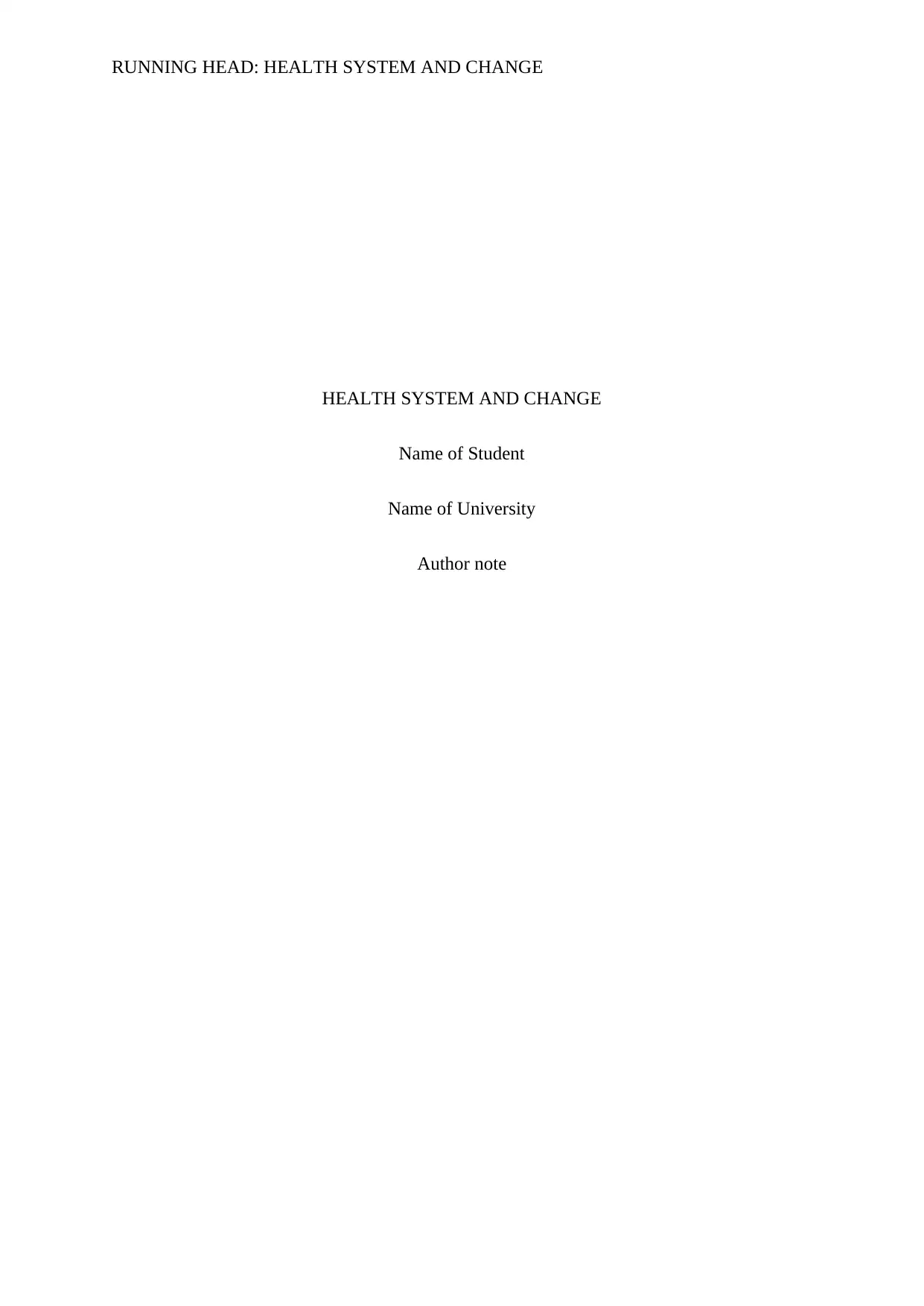
RUNNING HEAD: HEALTH SYSTEM AND CHANGE
HEALTH SYSTEM AND CHANGE
Name of Student
Name of University
Author note
HEALTH SYSTEM AND CHANGE
Name of Student
Name of University
Author note
Paraphrase This Document
Need a fresh take? Get an instant paraphrase of this document with our AI Paraphraser
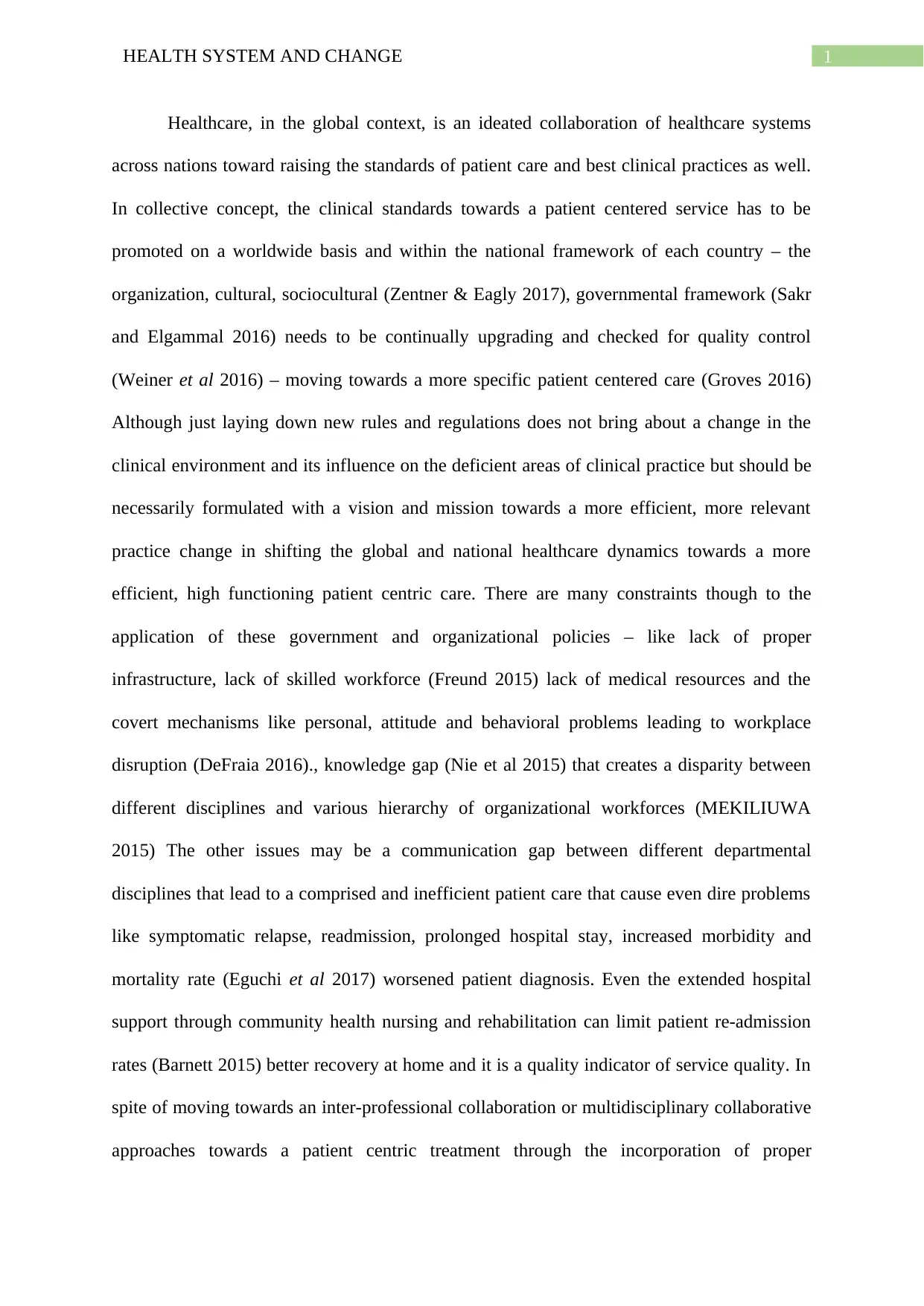
1HEALTH SYSTEM AND CHANGE
Healthcare, in the global context, is an ideated collaboration of healthcare systems
across nations toward raising the standards of patient care and best clinical practices as well.
In collective concept, the clinical standards towards a patient centered service has to be
promoted on a worldwide basis and within the national framework of each country – the
organization, cultural, sociocultural (Zentner & Eagly 2017), governmental framework (Sakr
and Elgammal 2016) needs to be continually upgrading and checked for quality control
(Weiner et al 2016) – moving towards a more specific patient centered care (Groves 2016)
Although just laying down new rules and regulations does not bring about a change in the
clinical environment and its influence on the deficient areas of clinical practice but should be
necessarily formulated with a vision and mission towards a more efficient, more relevant
practice change in shifting the global and national healthcare dynamics towards a more
efficient, high functioning patient centric care. There are many constraints though to the
application of these government and organizational policies – like lack of proper
infrastructure, lack of skilled workforce (Freund 2015) lack of medical resources and the
covert mechanisms like personal, attitude and behavioral problems leading to workplace
disruption (DeFraia 2016)., knowledge gap (Nie et al 2015) that creates a disparity between
different disciplines and various hierarchy of organizational workforces (MEKILIUWA
2015) The other issues may be a communication gap between different departmental
disciplines that lead to a comprised and inefficient patient care that cause even dire problems
like symptomatic relapse, readmission, prolonged hospital stay, increased morbidity and
mortality rate (Eguchi et al 2017) worsened patient diagnosis. Even the extended hospital
support through community health nursing and rehabilitation can limit patient re-admission
rates (Barnett 2015) better recovery at home and it is a quality indicator of service quality. In
spite of moving towards an inter-professional collaboration or multidisciplinary collaborative
approaches towards a patient centric treatment through the incorporation of proper
Healthcare, in the global context, is an ideated collaboration of healthcare systems
across nations toward raising the standards of patient care and best clinical practices as well.
In collective concept, the clinical standards towards a patient centered service has to be
promoted on a worldwide basis and within the national framework of each country – the
organization, cultural, sociocultural (Zentner & Eagly 2017), governmental framework (Sakr
and Elgammal 2016) needs to be continually upgrading and checked for quality control
(Weiner et al 2016) – moving towards a more specific patient centered care (Groves 2016)
Although just laying down new rules and regulations does not bring about a change in the
clinical environment and its influence on the deficient areas of clinical practice but should be
necessarily formulated with a vision and mission towards a more efficient, more relevant
practice change in shifting the global and national healthcare dynamics towards a more
efficient, high functioning patient centric care. There are many constraints though to the
application of these government and organizational policies – like lack of proper
infrastructure, lack of skilled workforce (Freund 2015) lack of medical resources and the
covert mechanisms like personal, attitude and behavioral problems leading to workplace
disruption (DeFraia 2016)., knowledge gap (Nie et al 2015) that creates a disparity between
different disciplines and various hierarchy of organizational workforces (MEKILIUWA
2015) The other issues may be a communication gap between different departmental
disciplines that lead to a comprised and inefficient patient care that cause even dire problems
like symptomatic relapse, readmission, prolonged hospital stay, increased morbidity and
mortality rate (Eguchi et al 2017) worsened patient diagnosis. Even the extended hospital
support through community health nursing and rehabilitation can limit patient re-admission
rates (Barnett 2015) better recovery at home and it is a quality indicator of service quality. In
spite of moving towards an inter-professional collaboration or multidisciplinary collaborative
approaches towards a patient centric treatment through the incorporation of proper
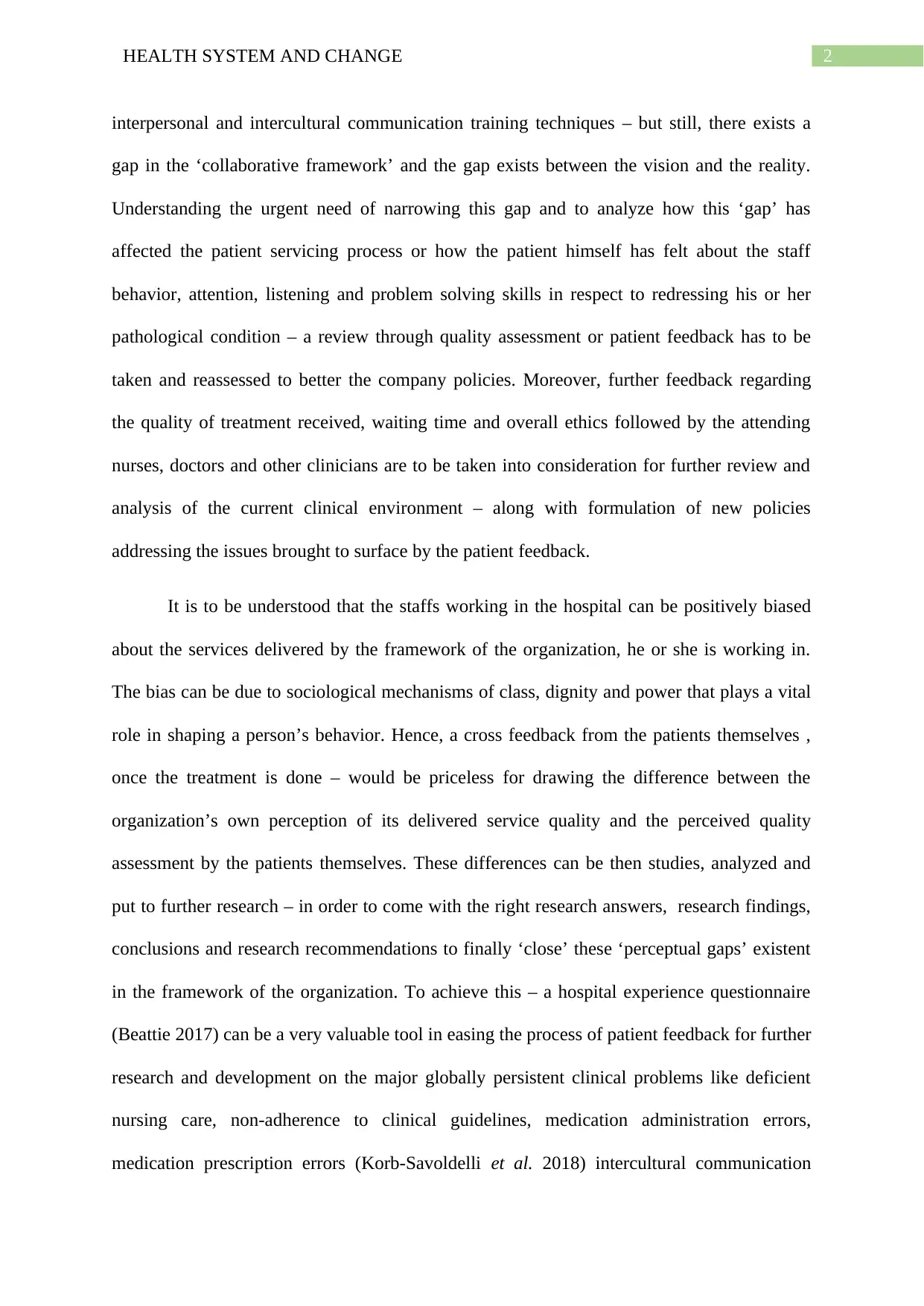
2HEALTH SYSTEM AND CHANGE
interpersonal and intercultural communication training techniques – but still, there exists a
gap in the ‘collaborative framework’ and the gap exists between the vision and the reality.
Understanding the urgent need of narrowing this gap and to analyze how this ‘gap’ has
affected the patient servicing process or how the patient himself has felt about the staff
behavior, attention, listening and problem solving skills in respect to redressing his or her
pathological condition – a review through quality assessment or patient feedback has to be
taken and reassessed to better the company policies. Moreover, further feedback regarding
the quality of treatment received, waiting time and overall ethics followed by the attending
nurses, doctors and other clinicians are to be taken into consideration for further review and
analysis of the current clinical environment – along with formulation of new policies
addressing the issues brought to surface by the patient feedback.
It is to be understood that the staffs working in the hospital can be positively biased
about the services delivered by the framework of the organization, he or she is working in.
The bias can be due to sociological mechanisms of class, dignity and power that plays a vital
role in shaping a person’s behavior. Hence, a cross feedback from the patients themselves ,
once the treatment is done – would be priceless for drawing the difference between the
organization’s own perception of its delivered service quality and the perceived quality
assessment by the patients themselves. These differences can be then studies, analyzed and
put to further research – in order to come with the right research answers, research findings,
conclusions and research recommendations to finally ‘close’ these ‘perceptual gaps’ existent
in the framework of the organization. To achieve this – a hospital experience questionnaire
(Beattie 2017) can be a very valuable tool in easing the process of patient feedback for further
research and development on the major globally persistent clinical problems like deficient
nursing care, non-adherence to clinical guidelines, medication administration errors,
medication prescription errors (Korb-Savoldelli et al. 2018) intercultural communication
interpersonal and intercultural communication training techniques – but still, there exists a
gap in the ‘collaborative framework’ and the gap exists between the vision and the reality.
Understanding the urgent need of narrowing this gap and to analyze how this ‘gap’ has
affected the patient servicing process or how the patient himself has felt about the staff
behavior, attention, listening and problem solving skills in respect to redressing his or her
pathological condition – a review through quality assessment or patient feedback has to be
taken and reassessed to better the company policies. Moreover, further feedback regarding
the quality of treatment received, waiting time and overall ethics followed by the attending
nurses, doctors and other clinicians are to be taken into consideration for further review and
analysis of the current clinical environment – along with formulation of new policies
addressing the issues brought to surface by the patient feedback.
It is to be understood that the staffs working in the hospital can be positively biased
about the services delivered by the framework of the organization, he or she is working in.
The bias can be due to sociological mechanisms of class, dignity and power that plays a vital
role in shaping a person’s behavior. Hence, a cross feedback from the patients themselves ,
once the treatment is done – would be priceless for drawing the difference between the
organization’s own perception of its delivered service quality and the perceived quality
assessment by the patients themselves. These differences can be then studies, analyzed and
put to further research – in order to come with the right research answers, research findings,
conclusions and research recommendations to finally ‘close’ these ‘perceptual gaps’ existent
in the framework of the organization. To achieve this – a hospital experience questionnaire
(Beattie 2017) can be a very valuable tool in easing the process of patient feedback for further
research and development on the major globally persistent clinical problems like deficient
nursing care, non-adherence to clinical guidelines, medication administration errors,
medication prescription errors (Korb-Savoldelli et al. 2018) intercultural communication
⊘ This is a preview!⊘
Do you want full access?
Subscribe today to unlock all pages.

Trusted by 1+ million students worldwide
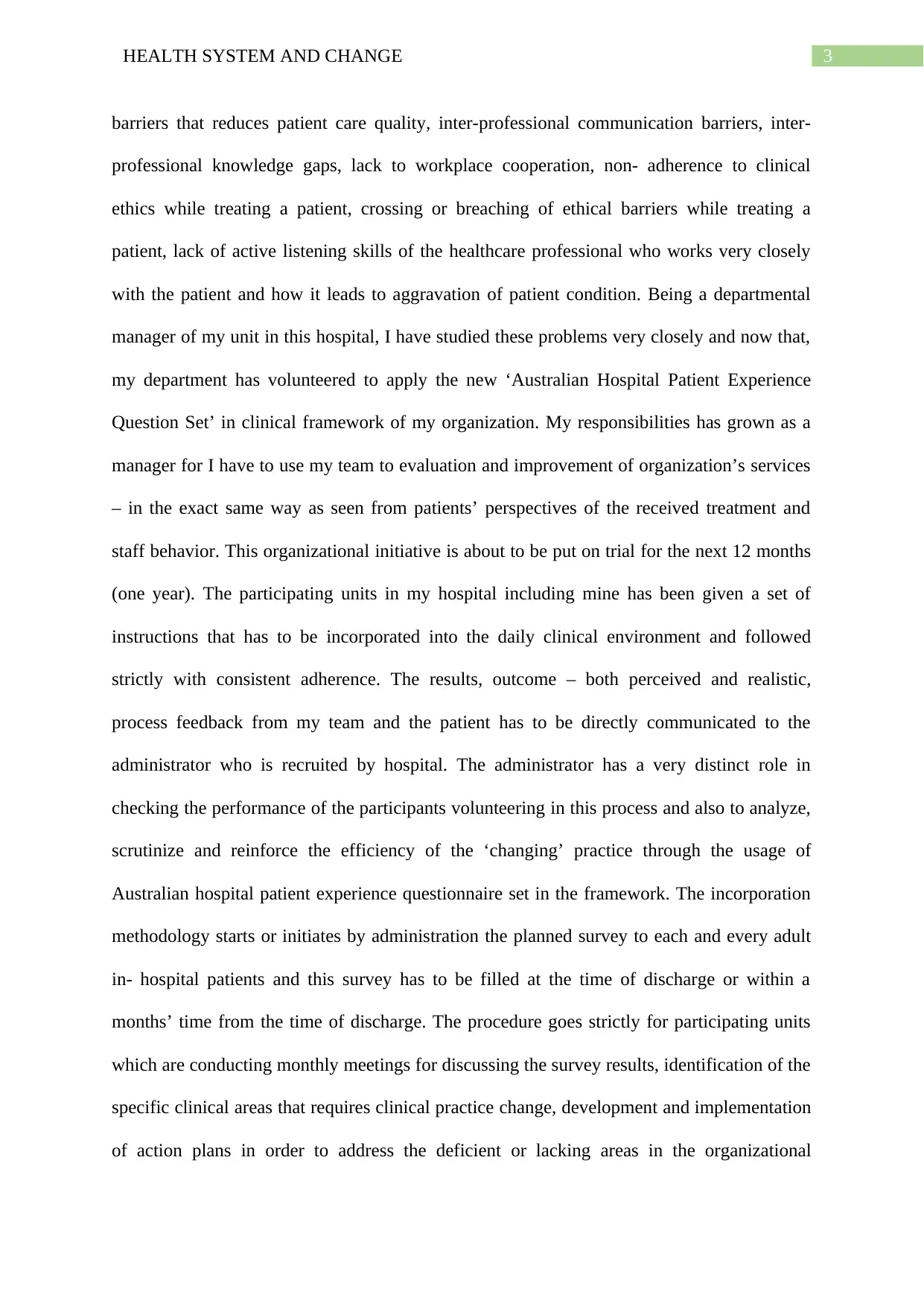
3HEALTH SYSTEM AND CHANGE
barriers that reduces patient care quality, inter-professional communication barriers, inter-
professional knowledge gaps, lack to workplace cooperation, non- adherence to clinical
ethics while treating a patient, crossing or breaching of ethical barriers while treating a
patient, lack of active listening skills of the healthcare professional who works very closely
with the patient and how it leads to aggravation of patient condition. Being a departmental
manager of my unit in this hospital, I have studied these problems very closely and now that,
my department has volunteered to apply the new ‘Australian Hospital Patient Experience
Question Set’ in clinical framework of my organization. My responsibilities has grown as a
manager for I have to use my team to evaluation and improvement of organization’s services
– in the exact same way as seen from patients’ perspectives of the received treatment and
staff behavior. This organizational initiative is about to be put on trial for the next 12 months
(one year). The participating units in my hospital including mine has been given a set of
instructions that has to be incorporated into the daily clinical environment and followed
strictly with consistent adherence. The results, outcome – both perceived and realistic,
process feedback from my team and the patient has to be directly communicated to the
administrator who is recruited by hospital. The administrator has a very distinct role in
checking the performance of the participants volunteering in this process and also to analyze,
scrutinize and reinforce the efficiency of the ‘changing’ practice through the usage of
Australian hospital patient experience questionnaire set in the framework. The incorporation
methodology starts or initiates by administration the planned survey to each and every adult
in- hospital patients and this survey has to be filled at the time of discharge or within a
months’ time from the time of discharge. The procedure goes strictly for participating units
which are conducting monthly meetings for discussing the survey results, identification of the
specific clinical areas that requires clinical practice change, development and implementation
of action plans in order to address the deficient or lacking areas in the organizational
barriers that reduces patient care quality, inter-professional communication barriers, inter-
professional knowledge gaps, lack to workplace cooperation, non- adherence to clinical
ethics while treating a patient, crossing or breaching of ethical barriers while treating a
patient, lack of active listening skills of the healthcare professional who works very closely
with the patient and how it leads to aggravation of patient condition. Being a departmental
manager of my unit in this hospital, I have studied these problems very closely and now that,
my department has volunteered to apply the new ‘Australian Hospital Patient Experience
Question Set’ in clinical framework of my organization. My responsibilities has grown as a
manager for I have to use my team to evaluation and improvement of organization’s services
– in the exact same way as seen from patients’ perspectives of the received treatment and
staff behavior. This organizational initiative is about to be put on trial for the next 12 months
(one year). The participating units in my hospital including mine has been given a set of
instructions that has to be incorporated into the daily clinical environment and followed
strictly with consistent adherence. The results, outcome – both perceived and realistic,
process feedback from my team and the patient has to be directly communicated to the
administrator who is recruited by hospital. The administrator has a very distinct role in
checking the performance of the participants volunteering in this process and also to analyze,
scrutinize and reinforce the efficiency of the ‘changing’ practice through the usage of
Australian hospital patient experience questionnaire set in the framework. The incorporation
methodology starts or initiates by administration the planned survey to each and every adult
in- hospital patients and this survey has to be filled at the time of discharge or within a
months’ time from the time of discharge. The procedure goes strictly for participating units
which are conducting monthly meetings for discussing the survey results, identification of the
specific clinical areas that requires clinical practice change, development and implementation
of action plans in order to address the deficient or lacking areas in the organizational
Paraphrase This Document
Need a fresh take? Get an instant paraphrase of this document with our AI Paraphraser
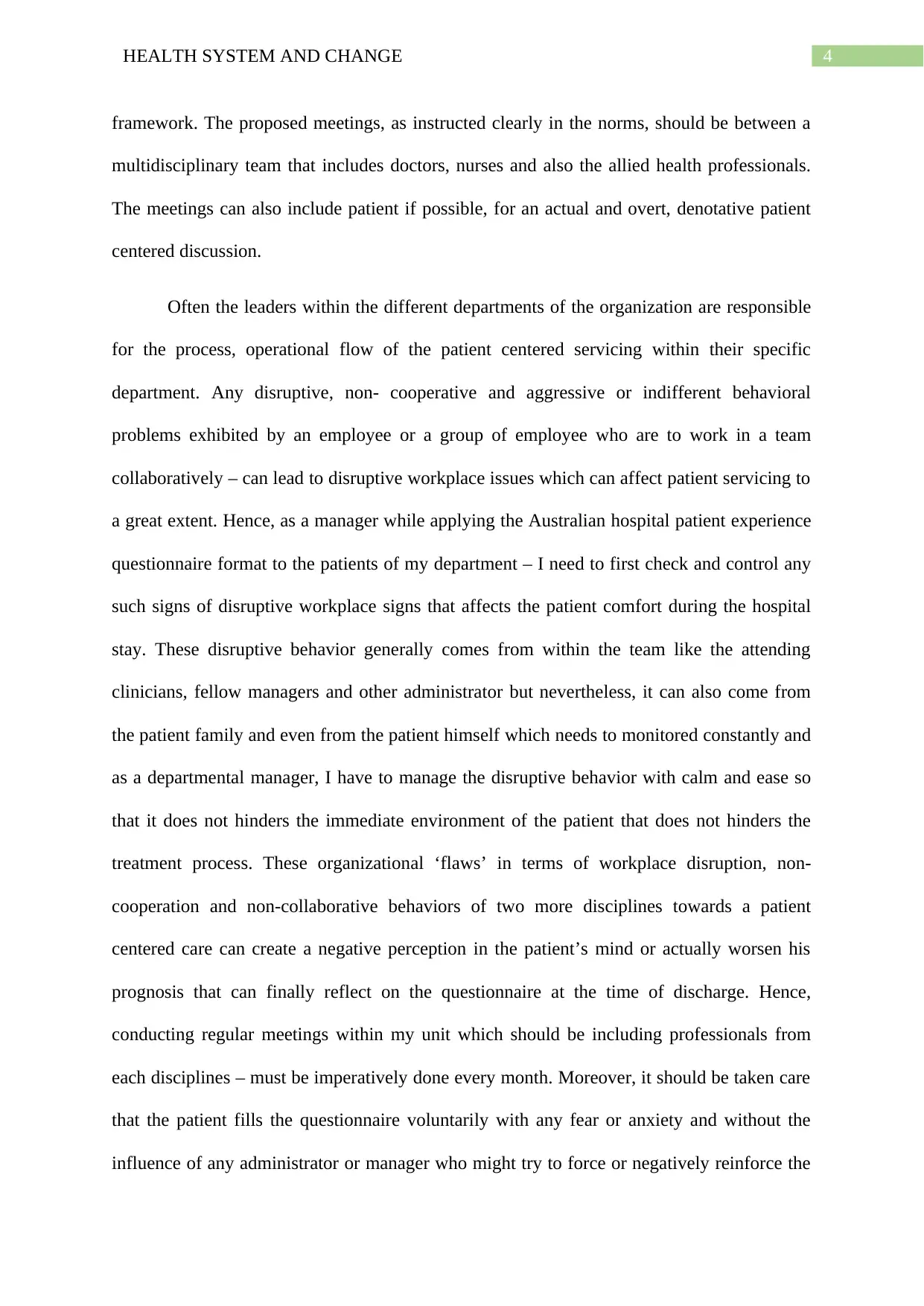
4HEALTH SYSTEM AND CHANGE
framework. The proposed meetings, as instructed clearly in the norms, should be between a
multidisciplinary team that includes doctors, nurses and also the allied health professionals.
The meetings can also include patient if possible, for an actual and overt, denotative patient
centered discussion.
Often the leaders within the different departments of the organization are responsible
for the process, operational flow of the patient centered servicing within their specific
department. Any disruptive, non- cooperative and aggressive or indifferent behavioral
problems exhibited by an employee or a group of employee who are to work in a team
collaboratively – can lead to disruptive workplace issues which can affect patient servicing to
a great extent. Hence, as a manager while applying the Australian hospital patient experience
questionnaire format to the patients of my department – I need to first check and control any
such signs of disruptive workplace signs that affects the patient comfort during the hospital
stay. These disruptive behavior generally comes from within the team like the attending
clinicians, fellow managers and other administrator but nevertheless, it can also come from
the patient family and even from the patient himself which needs to monitored constantly and
as a departmental manager, I have to manage the disruptive behavior with calm and ease so
that it does not hinders the immediate environment of the patient that does not hinders the
treatment process. These organizational ‘flaws’ in terms of workplace disruption, non-
cooperation and non-collaborative behaviors of two more disciplines towards a patient
centered care can create a negative perception in the patient’s mind or actually worsen his
prognosis that can finally reflect on the questionnaire at the time of discharge. Hence,
conducting regular meetings within my unit which should be including professionals from
each disciplines – must be imperatively done every month. Moreover, it should be taken care
that the patient fills the questionnaire voluntarily with any fear or anxiety and without the
influence of any administrator or manager who might try to force or negatively reinforce the
framework. The proposed meetings, as instructed clearly in the norms, should be between a
multidisciplinary team that includes doctors, nurses and also the allied health professionals.
The meetings can also include patient if possible, for an actual and overt, denotative patient
centered discussion.
Often the leaders within the different departments of the organization are responsible
for the process, operational flow of the patient centered servicing within their specific
department. Any disruptive, non- cooperative and aggressive or indifferent behavioral
problems exhibited by an employee or a group of employee who are to work in a team
collaboratively – can lead to disruptive workplace issues which can affect patient servicing to
a great extent. Hence, as a manager while applying the Australian hospital patient experience
questionnaire format to the patients of my department – I need to first check and control any
such signs of disruptive workplace signs that affects the patient comfort during the hospital
stay. These disruptive behavior generally comes from within the team like the attending
clinicians, fellow managers and other administrator but nevertheless, it can also come from
the patient family and even from the patient himself which needs to monitored constantly and
as a departmental manager, I have to manage the disruptive behavior with calm and ease so
that it does not hinders the immediate environment of the patient that does not hinders the
treatment process. These organizational ‘flaws’ in terms of workplace disruption, non-
cooperation and non-collaborative behaviors of two more disciplines towards a patient
centered care can create a negative perception in the patient’s mind or actually worsen his
prognosis that can finally reflect on the questionnaire at the time of discharge. Hence,
conducting regular meetings within my unit which should be including professionals from
each disciplines – must be imperatively done every month. Moreover, it should be taken care
that the patient fills the questionnaire voluntarily with any fear or anxiety and without the
influence of any administrator or manager who might try to force or negatively reinforce the
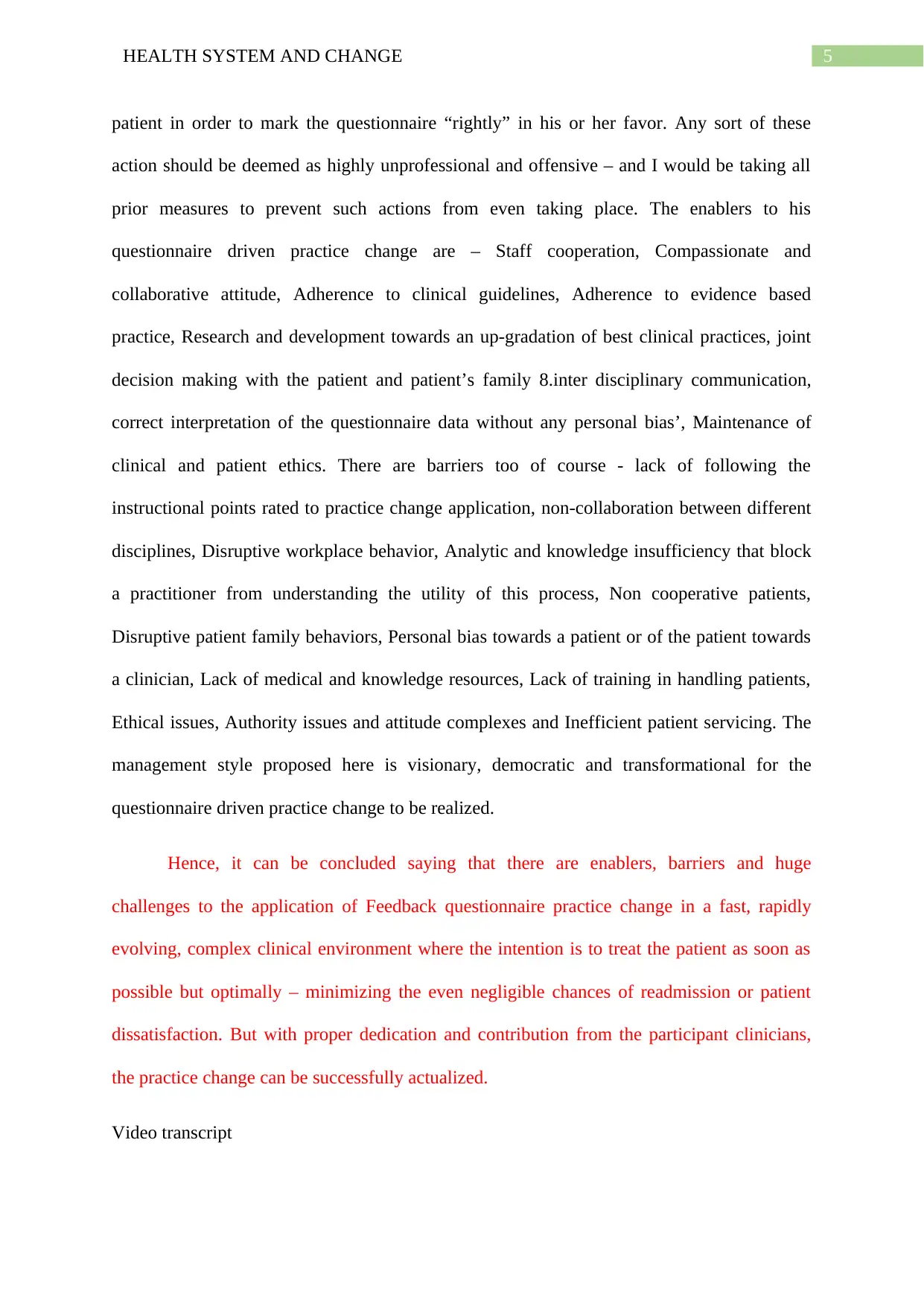
5HEALTH SYSTEM AND CHANGE
patient in order to mark the questionnaire “rightly” in his or her favor. Any sort of these
action should be deemed as highly unprofessional and offensive – and I would be taking all
prior measures to prevent such actions from even taking place. The enablers to his
questionnaire driven practice change are – Staff cooperation, Compassionate and
collaborative attitude, Adherence to clinical guidelines, Adherence to evidence based
practice, Research and development towards an up-gradation of best clinical practices, joint
decision making with the patient and patient’s family 8.inter disciplinary communication,
correct interpretation of the questionnaire data without any personal bias’, Maintenance of
clinical and patient ethics. There are barriers too of course - lack of following the
instructional points rated to practice change application, non-collaboration between different
disciplines, Disruptive workplace behavior, Analytic and knowledge insufficiency that block
a practitioner from understanding the utility of this process, Non cooperative patients,
Disruptive patient family behaviors, Personal bias towards a patient or of the patient towards
a clinician, Lack of medical and knowledge resources, Lack of training in handling patients,
Ethical issues, Authority issues and attitude complexes and Inefficient patient servicing. The
management style proposed here is visionary, democratic and transformational for the
questionnaire driven practice change to be realized.
Hence, it can be concluded saying that there are enablers, barriers and huge
challenges to the application of Feedback questionnaire practice change in a fast, rapidly
evolving, complex clinical environment where the intention is to treat the patient as soon as
possible but optimally – minimizing the even negligible chances of readmission or patient
dissatisfaction. But with proper dedication and contribution from the participant clinicians,
the practice change can be successfully actualized.
Video transcript
patient in order to mark the questionnaire “rightly” in his or her favor. Any sort of these
action should be deemed as highly unprofessional and offensive – and I would be taking all
prior measures to prevent such actions from even taking place. The enablers to his
questionnaire driven practice change are – Staff cooperation, Compassionate and
collaborative attitude, Adherence to clinical guidelines, Adherence to evidence based
practice, Research and development towards an up-gradation of best clinical practices, joint
decision making with the patient and patient’s family 8.inter disciplinary communication,
correct interpretation of the questionnaire data without any personal bias’, Maintenance of
clinical and patient ethics. There are barriers too of course - lack of following the
instructional points rated to practice change application, non-collaboration between different
disciplines, Disruptive workplace behavior, Analytic and knowledge insufficiency that block
a practitioner from understanding the utility of this process, Non cooperative patients,
Disruptive patient family behaviors, Personal bias towards a patient or of the patient towards
a clinician, Lack of medical and knowledge resources, Lack of training in handling patients,
Ethical issues, Authority issues and attitude complexes and Inefficient patient servicing. The
management style proposed here is visionary, democratic and transformational for the
questionnaire driven practice change to be realized.
Hence, it can be concluded saying that there are enablers, barriers and huge
challenges to the application of Feedback questionnaire practice change in a fast, rapidly
evolving, complex clinical environment where the intention is to treat the patient as soon as
possible but optimally – minimizing the even negligible chances of readmission or patient
dissatisfaction. But with proper dedication and contribution from the participant clinicians,
the practice change can be successfully actualized.
Video transcript
⊘ This is a preview!⊘
Do you want full access?
Subscribe today to unlock all pages.

Trusted by 1+ million students worldwide
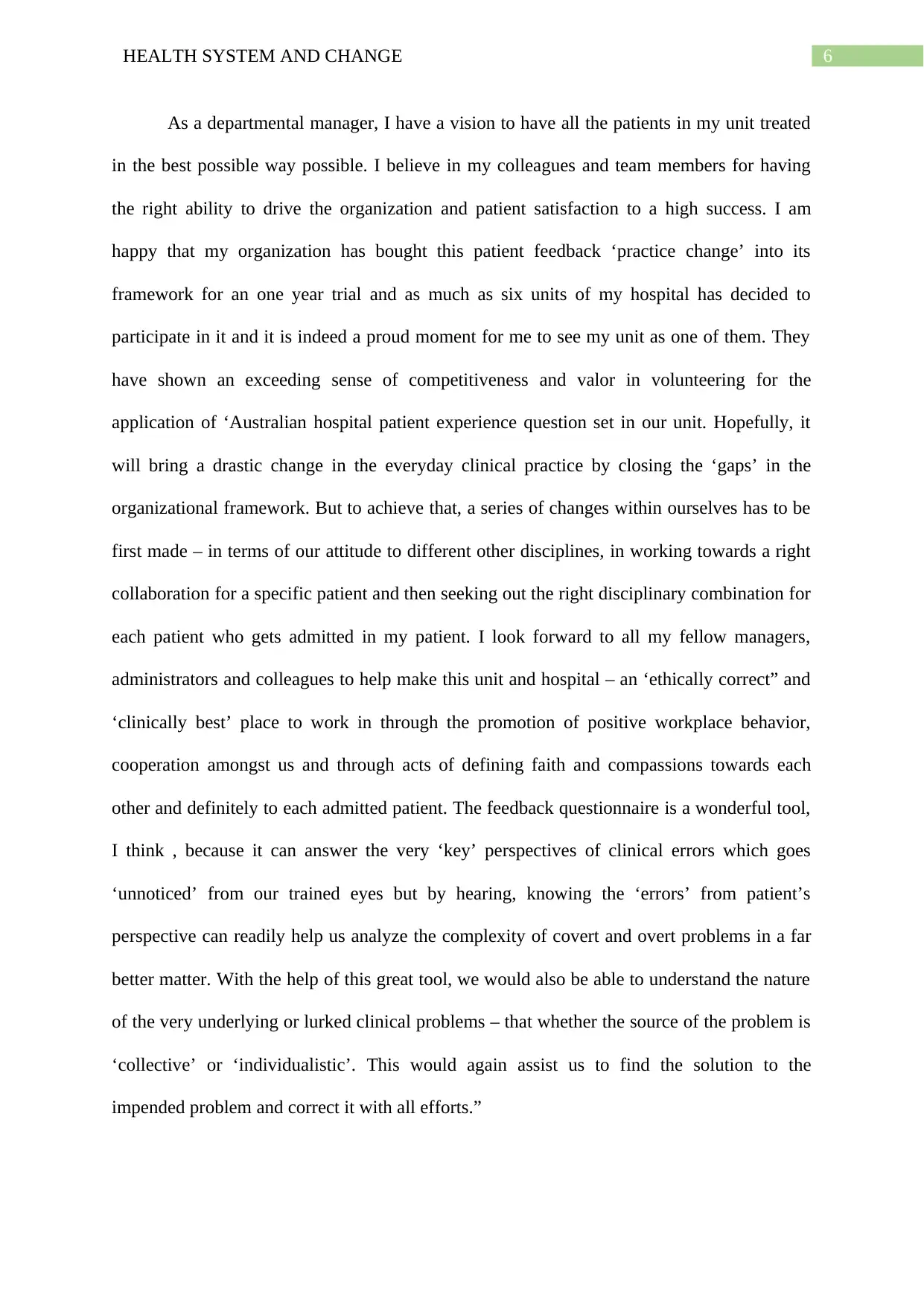
6HEALTH SYSTEM AND CHANGE
As a departmental manager, I have a vision to have all the patients in my unit treated
in the best possible way possible. I believe in my colleagues and team members for having
the right ability to drive the organization and patient satisfaction to a high success. I am
happy that my organization has bought this patient feedback ‘practice change’ into its
framework for an one year trial and as much as six units of my hospital has decided to
participate in it and it is indeed a proud moment for me to see my unit as one of them. They
have shown an exceeding sense of competitiveness and valor in volunteering for the
application of ‘Australian hospital patient experience question set in our unit. Hopefully, it
will bring a drastic change in the everyday clinical practice by closing the ‘gaps’ in the
organizational framework. But to achieve that, a series of changes within ourselves has to be
first made – in terms of our attitude to different other disciplines, in working towards a right
collaboration for a specific patient and then seeking out the right disciplinary combination for
each patient who gets admitted in my patient. I look forward to all my fellow managers,
administrators and colleagues to help make this unit and hospital – an ‘ethically correct” and
‘clinically best’ place to work in through the promotion of positive workplace behavior,
cooperation amongst us and through acts of defining faith and compassions towards each
other and definitely to each admitted patient. The feedback questionnaire is a wonderful tool,
I think , because it can answer the very ‘key’ perspectives of clinical errors which goes
‘unnoticed’ from our trained eyes but by hearing, knowing the ‘errors’ from patient’s
perspective can readily help us analyze the complexity of covert and overt problems in a far
better matter. With the help of this great tool, we would also be able to understand the nature
of the very underlying or lurked clinical problems – that whether the source of the problem is
‘collective’ or ‘individualistic’. This would again assist us to find the solution to the
impended problem and correct it with all efforts.”
As a departmental manager, I have a vision to have all the patients in my unit treated
in the best possible way possible. I believe in my colleagues and team members for having
the right ability to drive the organization and patient satisfaction to a high success. I am
happy that my organization has bought this patient feedback ‘practice change’ into its
framework for an one year trial and as much as six units of my hospital has decided to
participate in it and it is indeed a proud moment for me to see my unit as one of them. They
have shown an exceeding sense of competitiveness and valor in volunteering for the
application of ‘Australian hospital patient experience question set in our unit. Hopefully, it
will bring a drastic change in the everyday clinical practice by closing the ‘gaps’ in the
organizational framework. But to achieve that, a series of changes within ourselves has to be
first made – in terms of our attitude to different other disciplines, in working towards a right
collaboration for a specific patient and then seeking out the right disciplinary combination for
each patient who gets admitted in my patient. I look forward to all my fellow managers,
administrators and colleagues to help make this unit and hospital – an ‘ethically correct” and
‘clinically best’ place to work in through the promotion of positive workplace behavior,
cooperation amongst us and through acts of defining faith and compassions towards each
other and definitely to each admitted patient. The feedback questionnaire is a wonderful tool,
I think , because it can answer the very ‘key’ perspectives of clinical errors which goes
‘unnoticed’ from our trained eyes but by hearing, knowing the ‘errors’ from patient’s
perspective can readily help us analyze the complexity of covert and overt problems in a far
better matter. With the help of this great tool, we would also be able to understand the nature
of the very underlying or lurked clinical problems – that whether the source of the problem is
‘collective’ or ‘individualistic’. This would again assist us to find the solution to the
impended problem and correct it with all efforts.”
Paraphrase This Document
Need a fresh take? Get an instant paraphrase of this document with our AI Paraphraser
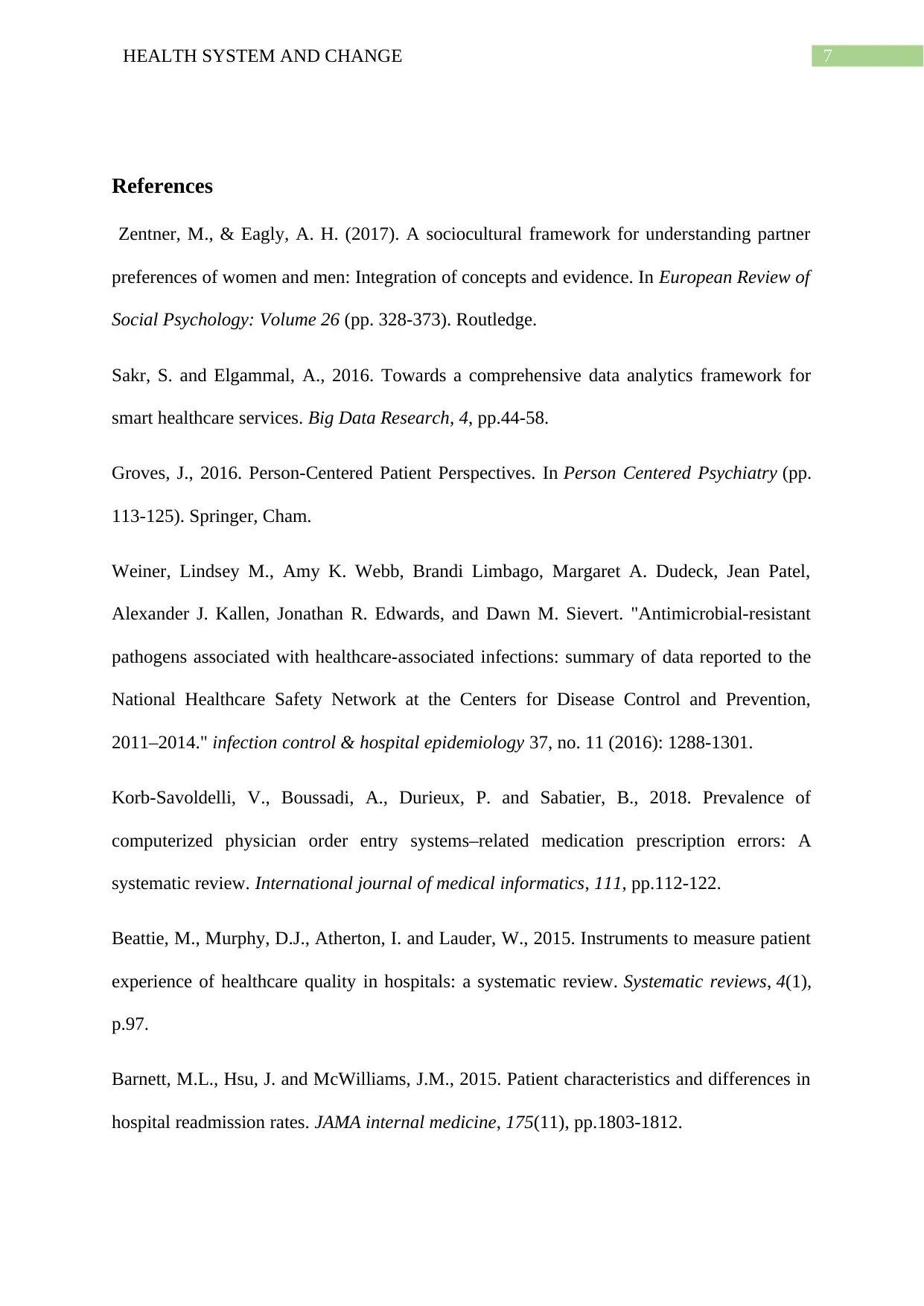
7HEALTH SYSTEM AND CHANGE
References
Zentner, M., & Eagly, A. H. (2017). A sociocultural framework for understanding partner
preferences of women and men: Integration of concepts and evidence. In European Review of
Social Psychology: Volume 26 (pp. 328-373). Routledge.
Sakr, S. and Elgammal, A., 2016. Towards a comprehensive data analytics framework for
smart healthcare services. Big Data Research, 4, pp.44-58.
Groves, J., 2016. Person-Centered Patient Perspectives. In Person Centered Psychiatry (pp.
113-125). Springer, Cham.
Weiner, Lindsey M., Amy K. Webb, Brandi Limbago, Margaret A. Dudeck, Jean Patel,
Alexander J. Kallen, Jonathan R. Edwards, and Dawn M. Sievert. "Antimicrobial-resistant
pathogens associated with healthcare-associated infections: summary of data reported to the
National Healthcare Safety Network at the Centers for Disease Control and Prevention,
2011–2014." infection control & hospital epidemiology 37, no. 11 (2016): 1288-1301.
Korb-Savoldelli, V., Boussadi, A., Durieux, P. and Sabatier, B., 2018. Prevalence of
computerized physician order entry systems–related medication prescription errors: A
systematic review. International journal of medical informatics, 111, pp.112-122.
Beattie, M., Murphy, D.J., Atherton, I. and Lauder, W., 2015. Instruments to measure patient
experience of healthcare quality in hospitals: a systematic review. Systematic reviews, 4(1),
p.97.
Barnett, M.L., Hsu, J. and McWilliams, J.M., 2015. Patient characteristics and differences in
hospital readmission rates. JAMA internal medicine, 175(11), pp.1803-1812.
References
Zentner, M., & Eagly, A. H. (2017). A sociocultural framework for understanding partner
preferences of women and men: Integration of concepts and evidence. In European Review of
Social Psychology: Volume 26 (pp. 328-373). Routledge.
Sakr, S. and Elgammal, A., 2016. Towards a comprehensive data analytics framework for
smart healthcare services. Big Data Research, 4, pp.44-58.
Groves, J., 2016. Person-Centered Patient Perspectives. In Person Centered Psychiatry (pp.
113-125). Springer, Cham.
Weiner, Lindsey M., Amy K. Webb, Brandi Limbago, Margaret A. Dudeck, Jean Patel,
Alexander J. Kallen, Jonathan R. Edwards, and Dawn M. Sievert. "Antimicrobial-resistant
pathogens associated with healthcare-associated infections: summary of data reported to the
National Healthcare Safety Network at the Centers for Disease Control and Prevention,
2011–2014." infection control & hospital epidemiology 37, no. 11 (2016): 1288-1301.
Korb-Savoldelli, V., Boussadi, A., Durieux, P. and Sabatier, B., 2018. Prevalence of
computerized physician order entry systems–related medication prescription errors: A
systematic review. International journal of medical informatics, 111, pp.112-122.
Beattie, M., Murphy, D.J., Atherton, I. and Lauder, W., 2015. Instruments to measure patient
experience of healthcare quality in hospitals: a systematic review. Systematic reviews, 4(1),
p.97.
Barnett, M.L., Hsu, J. and McWilliams, J.M., 2015. Patient characteristics and differences in
hospital readmission rates. JAMA internal medicine, 175(11), pp.1803-1812.
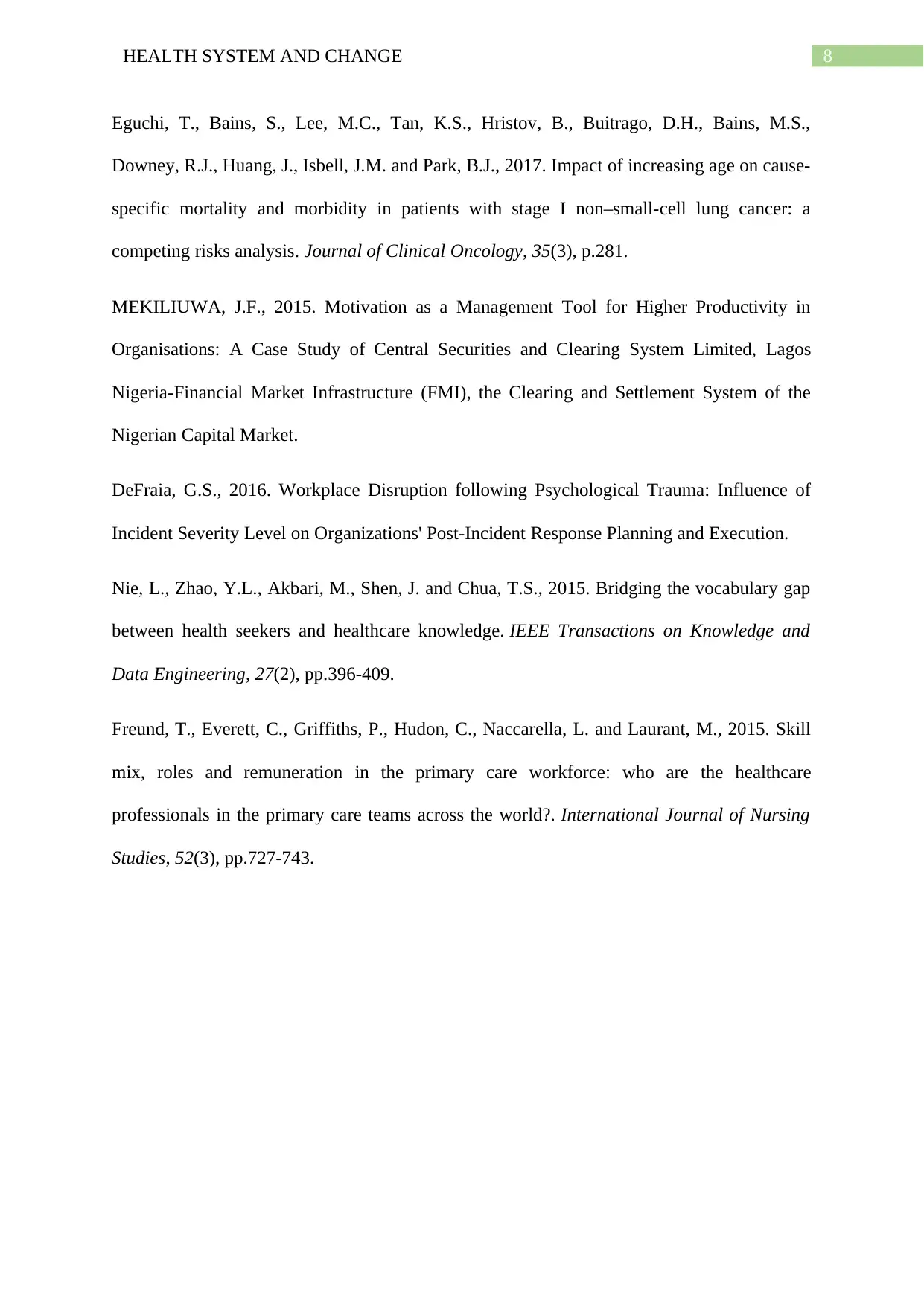
8HEALTH SYSTEM AND CHANGE
Eguchi, T., Bains, S., Lee, M.C., Tan, K.S., Hristov, B., Buitrago, D.H., Bains, M.S.,
Downey, R.J., Huang, J., Isbell, J.M. and Park, B.J., 2017. Impact of increasing age on cause-
specific mortality and morbidity in patients with stage I non–small-cell lung cancer: a
competing risks analysis. Journal of Clinical Oncology, 35(3), p.281.
MEKILIUWA, J.F., 2015. Motivation as a Management Tool for Higher Productivity in
Organisations: A Case Study of Central Securities and Clearing System Limited, Lagos
Nigeria-Financial Market Infrastructure (FMI), the Clearing and Settlement System of the
Nigerian Capital Market.
DeFraia, G.S., 2016. Workplace Disruption following Psychological Trauma: Influence of
Incident Severity Level on Organizations' Post-Incident Response Planning and Execution.
Nie, L., Zhao, Y.L., Akbari, M., Shen, J. and Chua, T.S., 2015. Bridging the vocabulary gap
between health seekers and healthcare knowledge. IEEE Transactions on Knowledge and
Data Engineering, 27(2), pp.396-409.
Freund, T., Everett, C., Griffiths, P., Hudon, C., Naccarella, L. and Laurant, M., 2015. Skill
mix, roles and remuneration in the primary care workforce: who are the healthcare
professionals in the primary care teams across the world?. International Journal of Nursing
Studies, 52(3), pp.727-743.
Eguchi, T., Bains, S., Lee, M.C., Tan, K.S., Hristov, B., Buitrago, D.H., Bains, M.S.,
Downey, R.J., Huang, J., Isbell, J.M. and Park, B.J., 2017. Impact of increasing age on cause-
specific mortality and morbidity in patients with stage I non–small-cell lung cancer: a
competing risks analysis. Journal of Clinical Oncology, 35(3), p.281.
MEKILIUWA, J.F., 2015. Motivation as a Management Tool for Higher Productivity in
Organisations: A Case Study of Central Securities and Clearing System Limited, Lagos
Nigeria-Financial Market Infrastructure (FMI), the Clearing and Settlement System of the
Nigerian Capital Market.
DeFraia, G.S., 2016. Workplace Disruption following Psychological Trauma: Influence of
Incident Severity Level on Organizations' Post-Incident Response Planning and Execution.
Nie, L., Zhao, Y.L., Akbari, M., Shen, J. and Chua, T.S., 2015. Bridging the vocabulary gap
between health seekers and healthcare knowledge. IEEE Transactions on Knowledge and
Data Engineering, 27(2), pp.396-409.
Freund, T., Everett, C., Griffiths, P., Hudon, C., Naccarella, L. and Laurant, M., 2015. Skill
mix, roles and remuneration in the primary care workforce: who are the healthcare
professionals in the primary care teams across the world?. International Journal of Nursing
Studies, 52(3), pp.727-743.
⊘ This is a preview!⊘
Do you want full access?
Subscribe today to unlock all pages.

Trusted by 1+ million students worldwide
1 out of 9
Related Documents
Your All-in-One AI-Powered Toolkit for Academic Success.
+13062052269
info@desklib.com
Available 24*7 on WhatsApp / Email
![[object Object]](/_next/static/media/star-bottom.7253800d.svg)
Unlock your academic potential
Copyright © 2020–2025 A2Z Services. All Rights Reserved. Developed and managed by ZUCOL.





